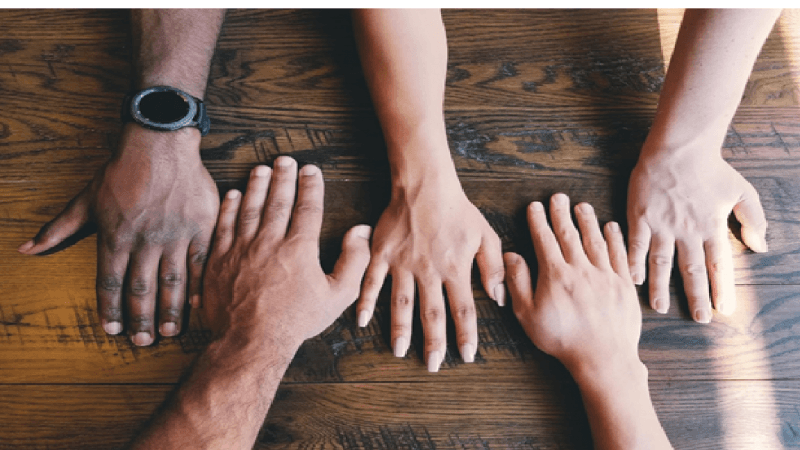Introduction

Towards solidarity and equality (By @claybanks on unsplash.com)
|
Inequality and discrimination are two difficult phenomena to measure, but they both cause many groups of people to be excluded from an active and participatory role in their community or even country. In many parts of the world income, gender, religion, sexual orientation and other personal conditions prevent people from having access to important parts of their lives. This activity aims at educating and sensitizing learners about concepts of inequality and discrimination, making them understand the complex nature of these issues in everyday life. Important to the full understanding of these topics is the psychological side of it because empathy remains the most important tool to the fight of inequality and discrimination. In order to promote a path towards an inclusive and equal society, the activity proposes both an exercise of exchange between the learners’ real-life experiences and an analysis of others’ experiences in the form of an interview. In this way learners will get in contact with their surroundings and with people from other parts of the world and other background stories. |
Learning Objectives
- The learner understands that inequality is a major driver for societal problems and individual dissatisfaction
- The learner is able to feel empathy for and to show solidarity with people who are discriminated against
- The learner becomes aware of inequalities in their surroundings as well as in the wider world and is able to recognize the problematic consequences
- The learner is able to identify and analyse different types of causes and reason for inequalities
- Strategic competency
- Collaboration competency
- Critical thinking competency
- Self-awareness competency
Instructions
|
Step 1) Box of thoughts (30 minutes) The learners are asked to think about any situation in their life when they felt privileged or discriminated against or also example of how discrimination or privilege occurs in daily life. Their thoughts, written on paper and with the possibility to leave the answer anonymous, will be folded and put in a box. The teacher will then open the box and share the thoughts with the class to introduce a group discussion on discrimination and inequality concepts with the help of video 2 and 3. The teacher can run the discussion by asking: What is discrimination? What does it mean to be discriminated against? What is inequality, according to learners? How does discrimination make those who suffers it make them feel? Is it fair? Is being different something that we should be ashamed of? Should we treat someone differently because he or she looks different? Step 2) Different but equal (60 minutes) The teacher clarifies the following concepts by recapping with the learners the overall thoughts they came up with and then by reading their definition from the dictionary:
To further consolidate the concepts and to give learners a practical example of them in past or contemporary events, the teachers divide the class in groups and assign to each group 1 or 2 newspapers/journal articles about the concepts previously discussed. The learners are asked to carefully read the articles and analyze their contents in order to understand if it contains cases of a) discrimination, b) diversity, c) inclusion or a combination of the three. Once the groups have analyzed their article, each group reports to the class a summary of the articles and what concepts they found, using if needed quotations from their article. In order to give an informed vision of their personal experiences, you should focus on the theme of vulnerability of refugees and migrants with the help of video 1 ('video' section) - 'Refugee Rights'. To finish each group comments the article and opens the space for a putting in common on the understanding worked. What are the most detected cases of discrimination? and inequality? How can work related to the study cycle help to create a fairer and more equal society? - CALL TO ACTION 1 Learners are asked to conduct interviews inside the educational center, or and in an organization who provides help and services for migrants, asylum seekers of refugees and collect information about instances in which the people interviewed felt discriminated against or excluded from the access of basic services, goods and rights. If possible, also a visit to a company dedicated to social and labor integration, where the learner can conduct interviews and learn about models used to minimize discrimination and favor equality in the labor market. - CALL TO ACTION 2 Using the results of the interviews, learners will organize awareness campaign through social media on the topics of discrimination and vulnerable people, for example a Facebook or Instagram page dedicated to fight discrimination and promotion of equality. |
Notes for Educators
Estimated Total Duration: 1 hours and 30 minutes + Call to Action
Step 1: The teacher can ask for the learners’ thoughts with the question “can you recall an instance when you felt treated differently?”
The reading of learners’ thought can be accompanied by videos (see "video" section):
- “SDG 10: Reduced Inequalities”
- “The Sustainable Development Goals Explained: Reduced Inequalities"
Step 2: The groups should be formed by 4 members. If possible at least one of the articles should be a case about refugees difficulties and asylum seekers' condition. Video “Refugee Rights” can be used.
Call to Action: The teacher has the responsibility to find suitable organizations where to visit and arrange a schedule. Interviews should contain questions similar to the one posed in the first part of the activity so that the learners can easily empathize with the interviewed people.









